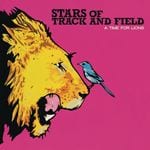
There’s a rule of thumb among the music industry’s more professionally-minded producers and songwriters that three minutes and 30 seconds is the ideal length for a pop song. It’s long enough for the rousing refrains to get repeated a few times, structurally it allows the inclusion of most major elements of a song (bridge, breakdown, perhaps a guitar motif), and, last but far from least, it’s the length that radio stations and late-night talk shows prefer. On the other hand, it’s not so long that it gets boring. Of the 11 songs on Stars of Track and Field’s new album, A Time for Lions, nine clock in between 3:20 and 3:32. The other two are ballads, and run around 4:45, which is the general consensus for ballad length.
This is not to say that Lions is the perfect record. More that it was professionally engineered, in the style of a car or coffee maker, to be perfect. Or, rather, its individual songs are. Each is as shiny, neatly packaged, and perfectly-structured for its task as a new toothbrush. This is where there’s a bit of a problem, however. Because the task for which this record was designed is mass appeal, the total aural saturation of airwaves, casual-dining restaurant mix CDs, movie trailers, and packed stadiums in the U.S., Europe, and Japan. It’s one thing when bands like U2 or Coldplay, acts to whom Stars owe a very large debt, make music with this kind of broad appeal. They’re like television networks; they have a built-in audience of millions they’re trying to retain and please. But when a band like Stars, who have about as many MySpace friends as my cousin’s (admittedly very popular) pop punk band makes this kind of music, a listener can be excused for finding it a bit odd, especially given that Stars made their name with a quirky, electronically-augmented record, 2006’s Centuries Before Love and War, an album which could not be further from the tracks collected on A Time for Lions.
And what of those tracks? While they don’t add up to a great record, they are occasionally brilliant pieces of pop. The album’s lead track, “Racing Lights”, is the obvious standout. Cymbals crash, guitars swell, and singer Kevin Calaba sings with heart-breaking earnestness about, well, it’s hard to say (racing lights are involved). It’s tailor-made for stadium shows and dramatic scenes on CW dramas. Calaba’s voice has a way of slipping into falsetto halfway through a word, as if he’s so full of emotion that he can’t control himself, a la Coldplay’s Chris Martin, a technique he begins using on “Racing Lights” and leans on for much of the record. Speaking of Coldplay, the album’s second track, “End of All Time”, begins with a lilting solo piano and high male singing voice which is soon joined by a strumming acoustic guitar, a style a listener would be excused for confusing with the work of that particular British group (see “Yellow”, “The Scientist”). Like Coldplay, and like many other songs on the record, it’s evocative and moving, if mysteriously so.
“The Stranger”, a song from near the end of the record, is another standout. Taking cues this time from Bends-era Radiohead, the band blends high, mournful vocals with looped electronic sounds and heavily reverbing guitars, producing an effect that feels like being reluctantly stuck in a never-ending cycle of oppressive sameness. Mixed with lyrics like “These days I feel like a stranger / Inside my polythene skin”, it’s a nice portrait of ennui.
A Time for Lions is likely to come as a bit of a surprise for anyone who was a fan of Centuries, with its emphasis shifted to mass-market pop engineering, Coldplay/U2-style. But then, the band would likely prefer to reach a whole new group of listeners, anyway. Here’s wishing them luck; if “Racing Lights” pops in every summer 2010 movie trailer, we’ll know they’ve made the right move.

![Call for Papers: All Things Reconsidered [MUSIC] May-August 2024](https://www.popmatters.com/wp-content/uploads/2024/04/all-things-reconsidered-call-music-may-2024-720x380.jpg)



